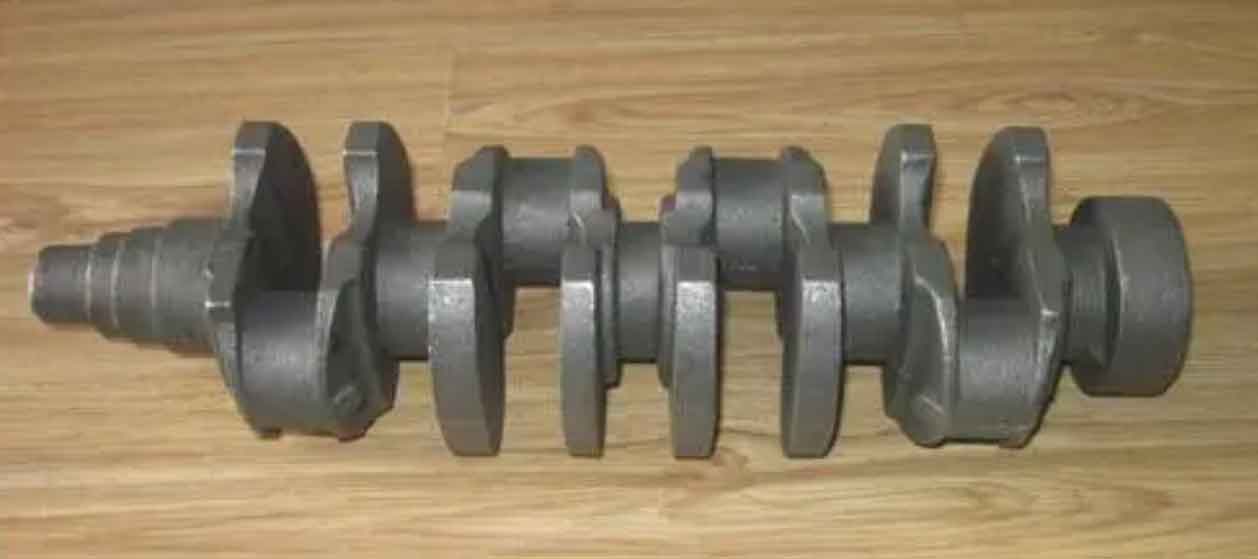The manufacturing process of cast crankshaft generally starts from the aspects of molten iron melting, spheroidizing treatment, inoculation treatment, alloying, modeling treatment and pouring to improve the comprehensive performance of nodular cast iron crankshaft.

(1) Melting of molten iron. In China, factories producing vehicle crankshafts usually use cupola, power frequency furnace, medium frequency furnace, cupola electric furnace and other equipment for molten iron smelting. Compared with cupola, electric furnace has higher overheating efficiency for molten iron, easier to control the composition of molten iron, and obtain molten iron with higher temperature, which is conducive to the preparation of high-quality vehicle crankshaft.
(2) Spheroidizing treatment. At present, the main components of spheroidizing agent used in China are magnesium and rare earth elements. Spheroidizing elements are divided into three categories according to their strength, and their spheroidizing conditions are also different. They have strong spheroidizing ability and are often used, including magnesium, cerium, lanthanum, yttrium and other rare earth elements, which can be spheroidized under general conditions; Medium spheroidization includes thorium, lithium, strontium, barium, sodium, potassium and cesium. It is required that the sulfur content of raw molten iron is very low; Zinc, cadmium, tin and pot have weak spheroidizing ability. The spheroidizing conditions require very low sulfur and rapid cooling. Rare earth ferrosilicon magnesium alloy is the most used spheroidizing agent in China, and pure magnesium is also a more used spheroidizing agent. Rare earth ferrosilicon is often added when spheroidizing with pure magnesium to offset the adverse effects of interfering elements.
(3) Inoculation treatment. The undercooling tendency of nodular cast iron increases after adding spheroidizing agent, and decreases after adding inoculant, which inhibits the precipitation of cementite and increases the roundness of graphite ball. Silicon based inoculants are widely used in casting production. Ferrosilicon is generally used. Barium ferrosilicon is used for large parts, barium ferrosilicon and bismuth ferrosilicon composite inoculants are used for thin parts, and silicon calcium is generally used for high-temperature molten iron. At the same time, the adding method of inoculant also has a great influence on the inoculation effect. The effect of inoculant is different when it is added to the cupola tapping tank or the spheroidizing agent in the spheroidizing ladle.
(4) Alloying. For the production of Pearlite Nodular Cast iron crankshaft, the secondary crystallization of nodular cast iron is mainly affected by alloying elements, and the pearlite structure is obtained by alloying. Due to the action of alloying elements, this kind of nodular cast iron has good mechanical properties or special properties. It can be used to replace alloy steel and has a wide development prospect. The most commonly used alloying elements in nodular cast iron in China are copper, molybdenum, manganese, silicon, tungsten, tin, vanadium, titanium and so on.
(5) Molding process. The casting process of nodular cast iron crankshaft is mainly divided into ordinary clay sand mold casting and special casting. Clay sand mold casting was widely used in the early years. Among them, shock (compaction) molding was once a common method in domestic crankshaft production. Although it has the advantages of advanced technology and high productivity, it has tended to be eliminated due to the disadvantages of insufficient hardness of mold surface and low sand mold accuracy; High pressure molding is characterized by high hardness and high precision of sand mold, but poor permeability of sand mold, poor hook of castings and high cost; The compactness and casting technology of air impact molding method are better than that of clay sand mold process, and the machine is simpler, but the disadvantage is that the hardness of mold is not as good as that of clay sand mold process. Special casting includes iron mold sand coated casting and shell mold iron shot filling casting. The former has many advantages, but it also has disadvantages, such as poor air permeability, easy to produce casting defects such as shrinkage and slag inclusion, and large equipment investment, which can only be suitable for the production of large quantities of finalized products; Shell mold iron shot filling process is a casting method in which the prepared shell mold is put into the barrel filled with steel shot to fix the shell mold, and then the molten iron is spared. The steel shot can accelerate the cooling speed of the casting, with the characteristics of good air permeability, easy recovery of steel shot, small equipment investment, slow mold consumption and easy change capacity.
(6) Pouring cooling process. Generally speaking, shaft castings have simple shape, large wall thickness and long solidification time, so it is easy to produce shrinkage defects. However, there is no great difference in wall thickness, so it is possible to realize small riser or no riser casting. At present, riser feeding is mostly used, and cold iron is used in the hot section where riser feeding cannot reach. For small and medium-sized shaft castings, the side riser is adopted, and the flat winding and flat cooling process is better; For castings with large shaft diameter, flat Rao vertical cooling process is adopted, vertical cooling is adopted, and the riser is located on it.
